Research Discussion Paper – RDP 2023-08 The Evolution of Consumer Payments in Australia: Results from the 2022 Consumer Payments Survey
1. Introduction
The Reserve Bank conducted its sixth triennial Consumer Payments Survey (CPS) in October to early December 2022. The CPS provides comprehensive data on how Australian consumers make their payments as well as qualitative information on payment preferences and attitudes. It is one of the main sources of information on the use of and attitudes towards different payment methods in Australia. A representative sample of just under 1,000 people participated in the 2022 CPS.
The way in which Australians are making payments is changing. New payment methods are emerging, often enabled by mobile technology, while transactional use of cash is declining. Moreover, the COVID-19 pandemic induced substantial changes in payment behaviour. The 2022 survey is the first CPS to be conducted since the pandemic and so provides a valuable snapshot of its effect on consumers' payment patterns.
2. Survey Overview
The CPS is a national cross-sectional survey that has been conducted every three years since 2007.[1] The 2022 CPS comprised three sections: a pre-diary questionnaire about the demographic characteristics of respondents; a payments diary; and a post-survey questionnaire focusing on respondents' payment preferences and attitudes. Participants recorded every transaction they made for seven days in the payments diary. The CPS provides unique insights into Australian consumers' payments behaviour and their changing preferences via both qualitative questions and quantitative analysis of the payments diaries.
The seven-day payments diary captured detailed information on every transaction that a consumer made in a week. The information included:
- the payment method – for example, debit card, credit card, cash or bank transfer
- the payment location – whether in-person or online
- the execution of the payment method – for example, by inserting a card into the terminal, or tapping a physical card or mobile device
- the payment purpose – for example, supermarket, household bills, leisure or transport.
The survey was delivered online for most respondents, except for participants without internet access who were recruited by telephone to complete a paper-based survey. Participants were recruited to the survey to ensure that the sample was consistent with population benchmarks for age, sex, household income, state of residence, credit card ownership and internet access (where necessary, the Reserve Bank weighted responses to align the sample with these benchmarks; see Appendix A.2 for more information).
A total of 999 people participated in the 2022 CPS, recording around 11,000 payments, 400 cash withdrawals and 1,900 automatic payments in their seven-day diary periods. For further details on the survey, see Appendix A.
3. Key Trends in Consumer Payments
The 2022 CPS showed a continuation of previous trends, with the longer-run shifts to electronic payment methods and away from cash accelerated by the pandemic. Debit cards were the most frequently used means of payment in 2022, making up half of all consumer payments (Figure 1). Overall, payment cards – debit and credit cards combined – were used for three-quarters of consumer payments in 2022, compared with 63 per cent three years earlier.

Source: RBA calculations, based on data from Colmar Brunton, Ipsos and Roy Morgan Research.
The trend towards increased use of electronic payment methods has been driven by the development of more convenient and seamless payment technology as well as changes in consumer behaviour, with the latter accelerated by the pandemic. In particular, payment cards now permit convenient contactless payments, where the cardholder can simply ‘tap’ the payment terminal, which speeds up transactions. There is wide merchant acceptance of contactless card payments, facilitated in recent years by new payment providers, including for low-value payments; this has made it unnecessary for many consumers to carry cash, eliminating the need to regularly top up their cash holdings. Innovation in the payments space has also meant that consumers can now make contactless card payments using their mobile phone, further increasing the convenience of card payments and decreasing the need to carry a physical wallet and cash. The share of in-person payments made by tapping a physical card or mobile device on a payment terminal increased to 77 per cent in 2022, from 56 per cent in 2019.
Consumers are using cards more frequently for payments of all sizes and the adoption of contactless functionality has facilitated particularly strong growth in the use of cards for low-value transactions in recent years. For example, the share of in-person payments of $10 or less that were made with cards rose by over 20 percentage points relative to three years earlier, to 73 per cent in 2022. There was also a further shift to making payments online rather than in person, with 18 per cent of consumer payments made online in 2022 up from 13 per cent in 2019, with most of these payments made using cards. Other means of online payment such as BPAY and internet banking applications account for relatively small shares of the number of consumer payments but a higher share when measured by the value of transactions (Table 1).
| 2007 | 2010 | 2013 | 2016 | 2019 | 2022 | |
|---|---|---|---|---|---|---|
| Number of payments | ||||||
| Cash | 69 | 62 | 47 | 37 | 27 | 13 |
| Cards | 26 | 31 | 43 | 52 | 63 | 76 |
| Debit cards | 15 | 22 | 24 | 30 | 44 | 51 |
| Credit and charge cards | 11 | 9 | 19 | 22 | 19 | 26 |
| BPAY | 2 | 3 | 3 | 2 | 2 | 2 |
| Internet/phone banking(a) | na | 2 | 2 | 1 | 3 | 3 |
| PayPal | na | 1 | 3 | 3 | 2 | 2 |
| Cheque | 1 | 1 | 0.4 | 0.2 | 0.2 | 0.1 |
| Other(b) | 1 | 1 | 2 | 4 | 2 | 2 |
| Value of payments | ||||||
| Cash | 38 | 29 | 18 | 18 | 11 | 8 |
| Cards | 43 | 43 | 53 | 54 | 61 | 65 |
| Debit cards | 21 | 27 | 22 | 26 | 36 | 39 |
| Credit and charge cards | 23 | 16 | 31 | 28 | 25 | 26 |
| BPAY | 10 | 10 | 11 | 8 | 9 | 8 |
| Internet/phone banking(a) | na | 12 | 10 | 10 | 14 | 14 |
| PayPal | na | 1 | 2 | 4 | 2 | 3 |
| Cheque | 6 | 3 | 2 | 2 | 2 | 0.05 |
| Other(b) | 3 | 3 | 5 | 3 | 2 | 3 |
|
Notes: Excludes payments over $9,999, transfers (payments to family and friends), transport cards and automatic payments.
Source: RBA calculations, based on data from Colmar Brunton, Ipsos and Roy Morgan Research. |
||||||
With Australian consumers increasingly opting to make their payments electronically, the trend decline in transactional use of cash has continued. In 2022, there were fewer consumers using cash exclusively and more that only used debit or credit cards (Figure 2). In past surveys consumers were more likely to have used multiple payment methods during the diary week, such as cash at some merchants and cards at other merchants. But consumers can now more easily rely on just cards for their day-to-day payments. This is because some merchants that previously only accepted cash, such as small food retailers, now accept card payments, and card payments are increasingly convenient due to contactless and mobile technology.

Note: Excludes respondents who made no in-person payments in the diary week.
Source: RBA calculations, based on data from Colmar Brunton, Ipsos and Roy Morgan Research.
Compared with 2019, consumers placed more importance on transaction speed when making their day-to-day payments, with around one-third of respondents selecting this as the most important factor when making an in-person payment (Figure 3). This result was consistent with consumers' shift towards contactless card payments over the same period.
The share of respondents indicating their preference for using own funds as the most important factor declined by 9 percentage points, which could partly explain why the ongoing shift towards debit card use slowed in this latest survey. There was also an increase in the share of respondents nominating ‘reward points’ as their most important factor in 2022, a factor associated with credit card use.

Source: RBA calculations, based on data from Ipsos and Roy Morgan Research.
Nonetheless, the 2022 CPS results showed that the majority of consumers continued to value merchant acceptance of debit cards, with around 90 per cent of respondents indicating that it was ‘very important’ or ‘important’ that a merchant accepts debit card payments (Figure 4). Merchant acceptance of cash was less important than acceptance of debit cards, but was relatively important for small purchases. By contrast, credit cards and buy now, pay later (BNPL) services were valued more by consumers for large purchases than small purchases. Even so, only around one-third of consumers felt that it was ‘very important’ or ‘important’ for merchants to accept BNPL for large purchases. This result is consistent with BNPL payments making up just 0.7 per cent of the number of payments in 2022.

Source: RBA calculations, based on data from Ipsos.
Similar trends in consumer payments have been apparent in several other economies. Data from broadly similar surveys conducted in a number of other advanced economies show that consumers globally are shifting away from cash to cards, although there are also some notable differences across economies (Figure 5).[2] Sweden and Norway are prominent examples of jurisdictions where cash is used for a relatively small proportion of consumer payments, whereas cash is more commonly used in some euro area economies.[3] China is another example of a country in which there has been a marked increase in the relative use of electronic payment methods, facilitated by the widespread adoption of digital wallet services.

Notes: Cash and card do not sum to 100. Observations are not directly comparable due to differing survey methods and inclusions across economies.
Sources: Bank of Canada; Colmar Brunton; De Nederlandsche Bank; Deutsche Bundesbank; European Central Bank; Federal Reserve Bank of San Francisco; Ipsos; Norges Bank; RBA; Roy Morgan Research; Sveriges Riksbank.
4. Cash
4.1 Cash payments
The decline of transactional cash use accelerated over the three years to 2022, with cash accounting for 13 per cent of the total number of consumer payments, compared to 27 per cent in 2019 (Figure 6). When measured by the value of consumer payments, the share of total payments made with cash declined more modestly from 11 per cent to 8 per cent. For in-person transactions, Australians halved their share of cash payments by number from 32 per cent to 16 per cent.
The decline in cash use was particularly pronounced for lower-value transactions, with consumers now more likely to use other payment methods for these payments. Indeed, non-cash methods (of which cards make up the overwhelming majority) overtook cash as the most frequently used payment method for all payment sizes for the first time in the 2022 CPS (Figure 7). Across all payment sizes, cash payments are most likely for round value transactions where change or coins are less likely to be needed (i.e. $5, $10, $20, $50 and $100 payments). The shift away from cash for lower-value payments reflects increased adoption of contactless electronic payments during and following the pandemic.

Source: RBA calculations, based on data from Colmar Brunton, Ipsos and Roy Morgan Research.

Note: $5-centred moving average; for example, the $6 share is an average of the payment method share at $4, $5, $6, $7 and $8.
Source: RBA calculations, based on data from Ipsos and Roy Morgan Research.
The decline in cash use was evident across key demographic groups, with consumers of all ages, income groups and locations using cash less frequently than previously (Figure 8). There was a particularly pronounced shift away from cash for groups typically associated with higher cash use, such as older age groups, those in regional and/or remote Australia, and those with lower household incomes. For example, consumers aged over 50 made just under 22 per cent of their in-person weekly payments in cash in 2022, compared with around 42 per cent three years earlier (and around 74 per cent in 2007). Similar declines were observed for people with lower household incomes and in regional/remote Australia.

Note: (a) Age-adjusted income quartiles.
Source: RBA calculations, based on data from Colmar Brunton, Ipsos and Roy Morgan Research.
The CPS suggests that the decline in cash use was accelerated by the pandemic. If cash use had followed its pre-pandemic trend, we would have expected the share of the number of in-person transactions made with cash to be 6 percentage points higher in 2022 (at 22 per cent) than eventuated (16 per cent). Higher frequency data – such as monthly aggregate ATM withdrawals across Australia and alternative surveys – indicate that the steep decline in cash use was due to a sharp decline at the beginning of the pandemic and then a relatively steady level of cash use at the lower level (Guttmann, Livermore and Zhang 2023). This suggests a ‘bring forward’ of a decline in cash use, rather than a change in trend per se.
The pandemic may have played a role in the relatively larger cash use decline for the elderly and those in regional and/or remote Australia. During the pandemic, consumers in general shifted away from cash partly because of hygiene concerns with handling cash. Fears of virus transmission were likely more acute for those in certain demographics, specifically the elderly (since the consequences are greater) and those in regional/remote areas (where distances to medical care may be greater) (McGrail and Humphreys 2015; Mueller, McNamara and Sinclair 2020).
4.2 Cash users and their attitudes towards cash
Most Australians used cash infrequently in 2022, if at all. Indeed, just over half of the respondents did not use cash at all during the diary week (‘no cash user’) in 2022, up from about one-third in 2019 and around one-fifth in 2016 (Figure 9). Including no cash users, almost three-quarters of Australians used cash for 20 per cent or less of their in-person transactions (‘low cash users’) in 2022, compared with half in 2019. The higher share of Australians using cash infrequently or not at all is consistent both with consumers preferring to pay with electronic methods and industry policies that encouraged and facilitated non-cash payment methods.

Note: Category based on share of in-person payments made with cash (no cash = 0 per cent, 0 per cent < low-but-some ≤ 20 per cent, 20 per cent < intermediate < 80 per cent, 80 per cent ≤ high-but-not-all < 100 per cent, all cash = 100 per cent).
Source: RBA calculations, based on data from Colmar Brunton, Ipsos and Roy Morgan Research.
However, some people still use cash for a significant share of their in-person payments. For example, around 5 per cent of CPS participants used cash for all their in-person transactions (‘all cash users’) in 2022 – the share having steadily declined from 16 per cent of people in 2007. Including all cash users, the share of people who used cash for 80 per cent or more of their in-person payments (‘high cash users’) declined to 7 per cent in 2022, from a little under half of the respondents in 2007.
The no cash and all cash user groups represent most of the low and high cash user groups respectively.[4] In the remainder of this paper, we focus the discussion on low cash users (including no cash users) and high cash users (including all cash users).[5]
While about 80 per cent of low cash users say they would be largely unaffected if cash became hard to use or access, a sizeable minority indicate some inconvenience (Figure 10). Of those who would experience a ‘major inconvenience’ or ‘genuine hardship’, high cash users are more likely to cite privacy/security concerns or family/budget reasons for needing cash (Figure 11).

Note: Category based on share of in-person payments made with cash (low ≤ 20 per cent, high ≥ 80 per cent).
Source: RBA calculations, based on data from Ipsos.

Notes: Share of respondents answering that they would experience a major inconvenience or genuine hardship to the question ‘Would it be difficult for you if shops stopped accepting cash and you could no longer withdraw cash?’. ‘Other’ category omitted. Category based on share of in-person payments made with cash (low ≤ 20 per cent, high ≥ 80 per cent). Payment method access/use limitation includes having no non-cash way to pay, not having enough money in bank account, not confident with non-cash methods, having a disability that makes it difficult to use non-cash methods, poor internet access, some businesses only accept cash and unable to get a bank account.
Source: RBA calculations, based on data from Ipsos.
While barriers to non-cash methods, like poor internet access or that some merchants only accept cash, still prevent some people from adopting other payment methods, they are relatively less important than in the past. For example, about 6 per cent of people stated they needed cash because ‘they have no other way to pay’ in 2019 – that share was under 1 per cent in 2022. One possible structural factor for this shift is that differences in ownership of internet-compatible mobile phones between the cash user groups are less evident than they were in 2019 (Figure 12). Additionally, government investment in regional/remote telecommunications infrastructure has increased (Australian Government 2022).

Note: Category based on share of in-person payments made with cash (low ≤ 20 per cent, 20 per cent < intermediate < 80 per cent, high ≥ 80 per cent).
Source: RBA calculations, based on data from Ipsos and Roy Morgan Research.
4.3 Cash holdings
Consistent with lower transactional cash use, fewer people held cash in their wallet or purse compared with 2019. Indeed, the share of people holding no cash on their person increased to 29 per cent in 2022 from 22 per cent in 2019 (Figure 13).[6] The share of lower-value holdings (under $50) decreased most, while higher-value on-person holdings remained relatively stable. The share of people holding cash in other places was unchanged from 2019 at around 40 per cent.
The stability in out-of-wallet cash holdings between 2019 and 2022, despite the sharp decline in transactional cash usage, is consistent with strong precautionary or store-of-wealth demand for banknotes. This is seen most in the growth of high denomination banknotes in circulation, particularly during times of crisis (Guttmann et al 2023). Indeed, the CPS suggests that many consumers perceive cash to be important as a backup payment method for when electronic payment methods are unusable. For example, of the people who held cash in their wallet, the most important reason for doing so – other than for day-to-day purchases – was for emergency transactions (about 20 per cent of respondents), followed by concerns about payments systems reliability. Emergency transactions was also the most important reason for holding cash outside the wallet.

Source: RBA calculations, based on data from Colmar Brunton, Ipsos and Roy Morgan Research.
4.4 Cash access
Consistent with the decline in the use of cash for transactions, the share of respondents making cash top-ups (i.e. receiving or withdrawing cash) during the survey week decreased: 29 per cent of respondents in the 2022 survey made at least one top-up, compared with 48 per cent in 2019 and 86 per cent in 2007 (Table 2). Similarly, the average number of top-ups halved – from 0.8 top-ups per week in 2019 to 0.4 per week in 2022. By age, older individuals were more likely to make at least one top-up during the week. By household income, those with lower income made more top-ups, although the relationship between income and top-ups is weaker than with age. In any case, these results are consistent with more transactional cash use in these demographics.
| 2007 | 2010 | 2013 | 2016 | 2019 | 2022 | |
|---|---|---|---|---|---|---|
| Share of respondents making one or more top-ups (%) | 86 | 72 | 76 | 45 | 48 | 29 |
| Average number of top-ups per person per week | 1.4 | 1.6 | 1.5 | 0.7 | 0.8 | 0.4 |
| Median value of top-ups ($) | 100 | 100 | 60 | 100 | 80 | 100 |
|
Source: RBA calculations, based on data from Colmar Brunton, Ipsos and Roy Morgan Research. |
||||||
To complement these top-ups data, in the 2022 CPS, respondents were asked to reflect on where they usually, and where they most prefer to, access their cash even if they did not do so during the survey week.[7] Across all cash user groups, people usually access cash from ATMs or cash out at the point-of-sale; these were also cited as the two most preferred ways to access cash (Figure 14).

Note: Category based on share of in-person payments made with cash (low ≤ 20 per cent, high ≥ 80 per cent).
Source: RBA calculations, based on data from Ipsos.
By cash use intensity, high cash users were more likely to state that they usually, and most prefer to, access cash at a bank branch or Bank@Post than low cash users. One possible reason this could be the case is if high cash users prefer the face-to-face service offered at these outlets. High cash users may also prefer bank branches because they are not faced with withdrawal limits. Low cash users, on the other hand, may prioritise convenience of the nearest cash access point over the features of the service. The recorded top-ups in the diary data reinforce this finding – of those who recorded a top-up, 93 per cent of high cash users topped-up from their most preferred top-up source, compared to about 70 per cent for low cash users.
The CPS suggests that the convenience of access to cash services differs between withdrawal and deposit services, although the difference has lessened in the recent survey. Almost all people use cash withdrawal services, and access is generally rated as convenient or very convenient; however, the share rating withdrawal services as convenient or very convenient has declined to 85 per cent in 2022 from 89 per cent in 2019 (Figure 15). By comparison, only around three-quarters of people use deposit services, and a smaller share of people rate these as convenient relative to withdrawal services. In 2022, 67 per cent of people rated deposit services as convenient or very convenient, which is an increase from 62 per cent in 2019. The shares of people who don't use withdrawal and deposit services increased since 2019, consistent with the decline in transactional cash use.

Source: RBA calculations, based on data from Ipsos and Roy Morgan Research.
Important vulnerabilities in cash access are emerging: the highest cash users and those in regional/remote areas find their access to both withdrawal and deposit services more inconvenient than they did in 2019 (Figure 16). For those in regional/remote areas, it is likely that the declining number of cash access points, and the distance to the next alternative, contributed to the increased inconvenience of access. While the decline in bank branches has been mostly concentrated in metropolitan areas, the greater distance to the ‘next closest’ access point in regional/remote Australia means closures are more acutely felt in these areas (Guttmann et al 2023).
For more intensive cash users, the ways they prefer to access cash, particularly via bank branches, may explain the decreased convenience of cash access. Access to bank branches has declined in recent years (Guttmann et al 2023). Indeed, other access points are not perfect substitutes for bank branches, which offer a broader range of services (e.g. no withdrawal limits). This might mean when a branch closes, people who rely on those services find cash access more inconvenient than before.

Note: Share of respondents answering that deposit or withdrawal services are inconvenient or very inconvenient.
Source: RBA calculations, based on data from Ipsos and Roy Morgan Research.
5. Card Payments
5.1 Card use
The results of the 2022 CPS show that Australians continued to shift to using cards for their day-to-day transactions. Since the CPS was first conducted in 2007, cards have been replacing cash and have become the dominant payment method.[8] In 2022, three-quarters of payments were made with cards – three times the share in 2007 (Table 1). In value terms, payments made using cards accounted for two-thirds of the total value of payments in 2022, an increase of 24 percentage points from 2007. The increase in card usage mirrors the decline in cash usage.
The rising popularity of cards reflects both changing consumer preferences and widespread acceptance of electronic payments by merchants. Australian consumers have increasingly preferred to use cards to make payments as new technology and innovation in the payments space have made cards more convenient and easier to use. Cards have become very popular for Australian consumers: 99 per cent of respondents in the 2022 CPS reported that they held at least one debit and/or credit card and just under half indicated that they held both types of cards. Merchant acceptance is also very high; a Reserve Bank survey in 2022 found that 97 per cent of retail merchants accepted card payments.[9] The high rate of card acceptance by merchants partly reflects the ubiquity of card ownership and use among consumers, as well as reductions in merchant acceptance fees over time and Reserve Bank reforms making it possible for merchants to surcharge for card payments (Gill, Holland and Wiley 2022). Wider card acceptance in recent years also appears to have been facilitated by new payments providers catering to small and micro merchants, as well as more convenient technology such as simpler point-of-sale terminals and mobile payment terminals.
Cards are now used widely across demographic groups, though some important differences remain. Younger people use cards most intensively, with consumers aged 18–29 years using cards for around 85 per cent of their payments (Figure 17, left panel). Consumers aged 65 and above were historically high cash users; however, they now use cards for nearly two-thirds of their payments. Compared with 2019, the share of transactions made using cards rose most strongly for consumers aged 40 years and older, with the rise mainly driven by a strong increase in card payments for low-value transactions. The increase in card use was more modest for consumers under 40, as for this group the share of low-value payments made using cards had already reached a high level in 2019.
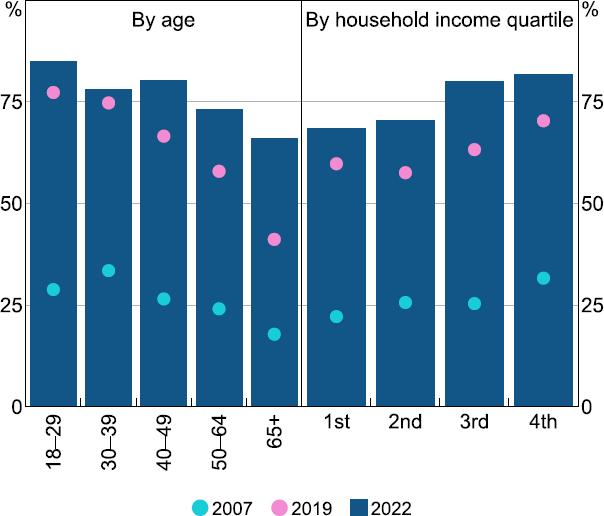
Note: Because of the overlap between age and income groups, the data for income quartiles are adjusted for respondent's age.
Source: RBA calculations, based on data from Ipsos and Roy Morgan Research.
The rise in the share of card payments between 2019 and 2022 was evident across all income groups (Figure 17, right panel). The growth in card usage was strongest in the middle-income groups (i.e. the second and third income quartiles). High-income households had the greatest propensity to use cards, with cards accounting for 82 per cent of their payments, compared with 69 per cent for those in the lowest income quartile.
In 2022, cards were used more frequently than in 2019 for payments of nearly all sizes. The increase in relative card use was most pronounced for lower-value transactions (Table 3). The one category where the share of card payments declined was for payments over $500, as more of these large transactions were made using other payment methods such as bank transfers and PayPal.
| 2007 | 2010 | 2013 | 2016 | 2019 | 2022 | |
|---|---|---|---|---|---|---|
| Payment value ($) | ||||||
| 1–10 | 4 | 7 | 18 | 32 | 52 | 72 |
| 11–20 | 21 | 26 | 39 | 52 | 64 | 78 |
| 21–50 | 40 | 43 | 54 | 61 | 70 | 79 |
| 51–100 | 54 | 59 | 63 | 65 | 74 | 79 |
| 101–500 | 51 | 53 | 59 | 62 | 64 | 74 |
| 501+ | 49 | 41 | 51 | 50 | 52 | 49 |
| Broad merchant categories | ||||||
| Supermarket | 39 | 46 | 59 | 63 | 74 | 84 |
| Food retail | 10 | 14 | 27 | 43 | 62 | 81 |
| Goods retail | 35 | 40 | 48 | 55 | 67 | 76 |
| Transport(a) | 15 | 17 | 34 | 49 | 71 | 87 |
| Petrol/service station | 51 | 54 | 66 | 67 | 76 | 84 |
| Leisure/entertainment | 12 | 19 | 36 | 37 | 50 | 64 |
| Holiday | 65 | 69 | 74 | 79 | 81 | 78 |
| Bills(b) | 28 | 22 | 33 | 35 | 29 | 33 |
| Services | 27 | 33 | 38 | 46 | 48 | 62 |
| Other | 25 | 30 | 41 | 47 | 56 | 66 |
|
Notes: Excludes payments over $9 999, transfers (payments to family and friends) and automatic payments.
Source: RBA calculations, based on data from Colmar Brunton, Ipsos and Roy Morgan Research. |
||||||
The 2022 CPS showed that cards were the predominant payment method at almost all types of businesses (Table 3). Cards accounted for more than 80 per cent of transactions at supermarkets, food retailers, transport businesses, and petrol and service stations. The high share of card payments at supermarkets may reflect the convenience of using a card at these businesses – for instance, supermarkets were among the first businesses to introduce contactless card terminals in Australia and have recently introduced self-service checkouts that do not accept cash. In addition, many supermarkets do not surcharge card payments, making this payment method a more attractive choice than at businesses that do surcharge. Card payments are used least for household bills, with consumers tending to use lower-cost payment methods such as bank transfers and BPAY for these payments.
5.2 Credit and debit cards
The increase in card usage over the last decade has reflected greater use of both debit and credit cards. Since 2007, consumers have consistently increased their usage of debit cards. Payments made using debit cards accounted for half of all payments in 2022 – more than three times their share in 2007. The increased use was initially supported by the introduction of debit cards that provided much of the same payment functionality as credit cards, such as the ability to make online payments. More recently, in response to the pandemic, banks sent debit cards to Australian account holders who did not have a linked debit card (e.g. passbook holders), making debit cards even more widely available. The stronger uptake of debit cards partly reflects Australian consumers preferring to use their own funds from their deposit account, rather than borrowed funds from a credit card. Particularly over the last few years, younger consumers have consistently shown a greater preference for using their own funds. In addition, the decline in the generosity of credit card reward programs and generally higher surcharges for credit cards than debit cards have meant that consumers have opted to use debit cards more often as they switch away from cash payments.[10]
The usage of credit and debit cards varies by household income. Lower-income households use debit cards and cash more frequently than higher-income households. In 2022, consumers in the lowest income quartile made 55 per cent of their transactions with debit cards, compared with 45 per cent for those in the highest income quartile (Figure 18, left panel). By contrast, consumers in the highest income quartile used credit cards for around one-third of their total payments, which is three times the share for consumers in the lowest income quartile. This may reflect higher-income households being more likely to meet the lending standards for a credit card, as well as debit cards and cash being used as budgeting tools for lower-income households.
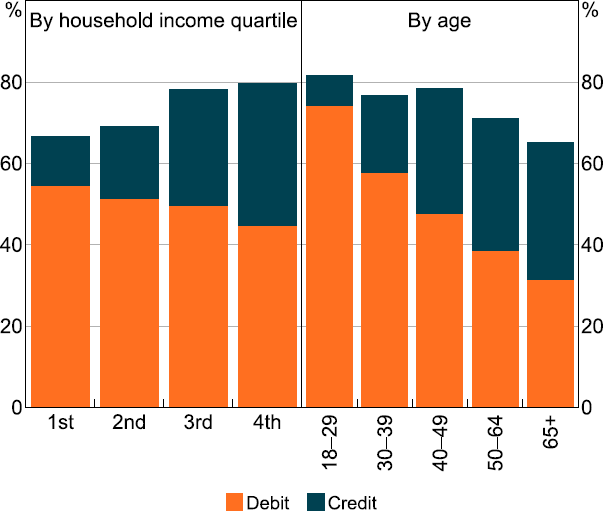
Note: Because of the overlap between age and income groups, the data for income quartiles are adjusted for respondent's age.
Source: RBA calculations, based on data from Ipsos.
The use of credit and debit cards diverges across age groups. Younger consumers are more likely to use debit cards more intensively whereas older consumers tend to use credit cards and cash more frequently to make payments. In 2022, consumers aged 18–29 made three-quarters of their total transactions with debit cards – more than double the share for consumers over 65 (Figure 18, right panel). While consumers of all ages used debit cards more frequently than they did in the previous survey, the recent increase has been most pronounced among consumers aged under 30 and over 65. The share of payments made using debit cards by these groups increased by around 10 percentage points between the 2019 and 2022 surveys. For consumers aged over 40 the share of payments using credit cards increased significantly. However, consumers aged under 40 used credit cards less frequently than they did in 2019 (Figure 19).
Consumers aged under 30 made more than three-quarters of their payments using debit cards (Figure 20). While this age group are less likely to hold a credit card than those in other age cohorts, younger people that own a credit card still made over half of their payments using a debit card.[11] In contrast, consumers aged over 50 made around one-third of their payments with a debit card, with a less pronounced difference in debit card use between those who held a credit card and those who did not.
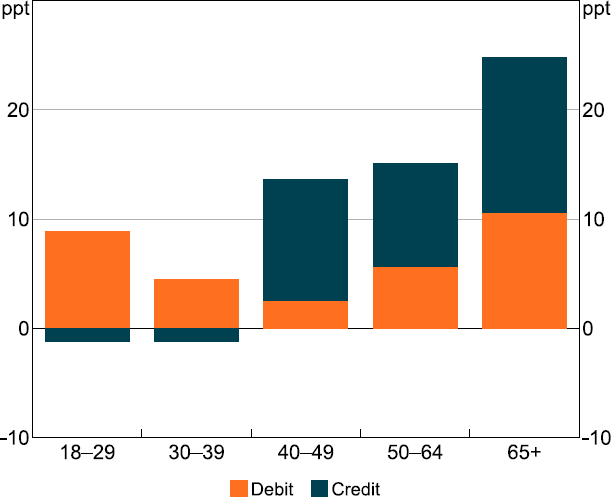
Source: RBA calculations, based on data from Ipsos and Roy Morgan Research.
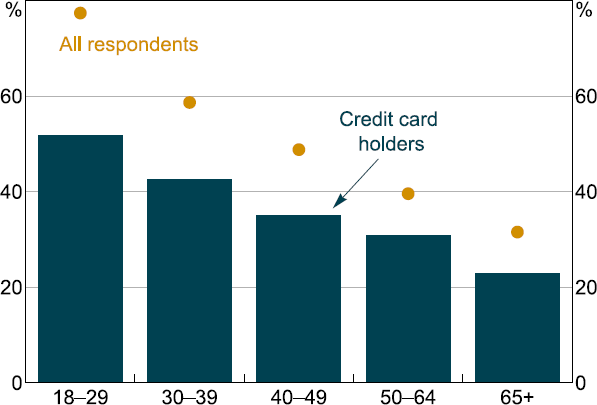
Source: RBA calculations, based on data from Ipsos.
5.3 Contactless and mobile card payments
The way Australians undertake their payments has changed significantly over the past decade. Most in-person card payments are now made using contactless functionality, including through the use of mobile devices.[12] In 2022, these payments made up 95 per cent of in-person card payments, an increase of 10 percentage points from 2019 (Figure 21). By contrast, when the CPS was first conducted in 2007, almost all in-person card transactions were made by swiping or inserting the card into a terminal at the store checkout (and providing a personal identification number (PIN) or signature for verification). In 2022, these payments made up only 5 per cent of in-person card payments.
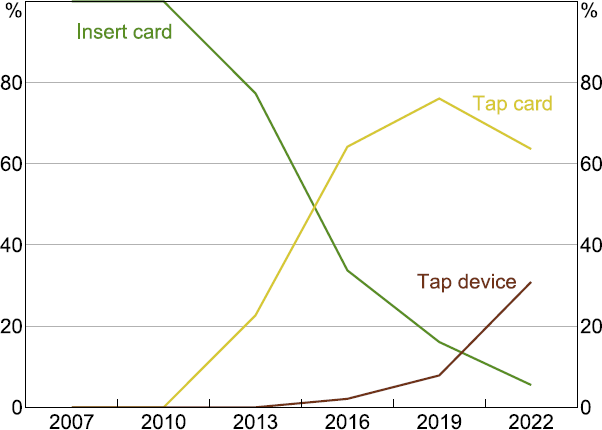
Source: RBA calculations, based on data from Colmar Brunton, Ipsos and Roy Morgan Research.
Most contactless payments were initiated by tapping a physical card on a point-of-sale terminal. But the use of mobile devices to make contactless payments – by tapping a smartphone or other payment-enabled mobile device, such as a watch, ring or other ‘wearable’ device – increased sharply from a low base. Contactless mobile payments accounted for nearly one-third of in-person card payments in 2022, up from just 8 per cent in 2019 (Figure 21). The increased adoption of contactless mobile payments has been supported by this payment option becoming more widely available to consumers, due to the increased availability of devices equipped with mobile payment functionality combined with most card issuers supporting the storage of their cards in mobile wallets (such as those provided by Apple, Google and Samsung). Adoption has also been supported by consumers' greater awareness of this payment method, as well as widespread merchant acceptance of contactless card payments more generally.
The pandemic also contributed to greater adoption of contactless payments by changing the behaviour of consumers, merchants and payment providers. Consumers shifted towards electronic payment methods because of hygiene concerns with handling cash and an increase in online payments due to lockdowns and social distancing. During the pandemic, the payments industry also facilitated a move to contactless transactions by increasing the transaction limit below which a PIN was not required for a contactless card payment from $100 to $200.[13] Between 2019 and 2022, the share of contactless payments increased by 35 percentage points for payments over $100 – a stronger rise than for lower-value transactions (Figure 22). Consumers mainly switched from inserting a card to using contactless payments for these larger payments. Nonetheless, the use of contactless functionality by consumers also increased significantly for lower-value transactions. For example, the share of in-person payments of $10 or less made by tapping a card or a mobile device increased by 24 percentage points between 2019 and 2022, to 48 per cent. For payments of this size, consumers generally substituted from cash to contactless mobile device payments.
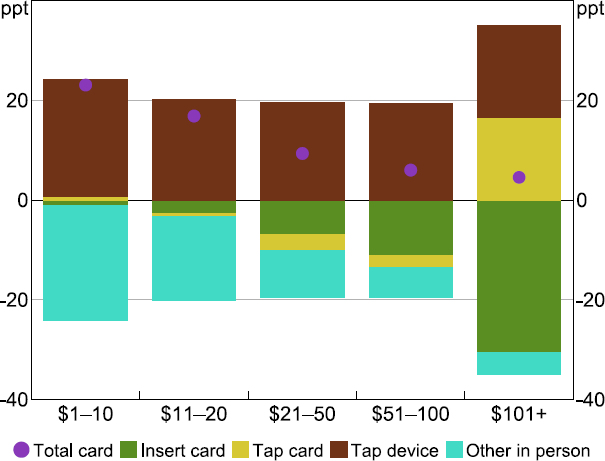
Source: RBA calculations, based on data from Ipsos and Roy Morgan Research.
The use of mobile wallets increased for Australians of all ages between 2019 and 2022. In 2022, more than one-third of consumers used a mobile device to make a contactless payment in the diary week – an increase of 25 percentage points from 2019. The increase in adoption was particularly pronounced for younger consumers. Mobile payments were used by nearly two-thirds of Australians aged between 18 and 29 in 2022, up from less than 20 per cent in 2019. For consumers aged 65 and over, only 9 per cent made a mobile payment during the diary week, although this was triple the share in 2019 (Figure 23, top panel). In 2022, mobile devices were used intensively by those consumers who had adopted mobile payments, and this trend was evident across all age groups – mobile device payments accounted for more than half of such consumers' in-person payments. Users aged over 65 recorded a particularly strong increase in their intensity of mobile payment usage between 2019 and 2022 (Figure 23, bottom panel).
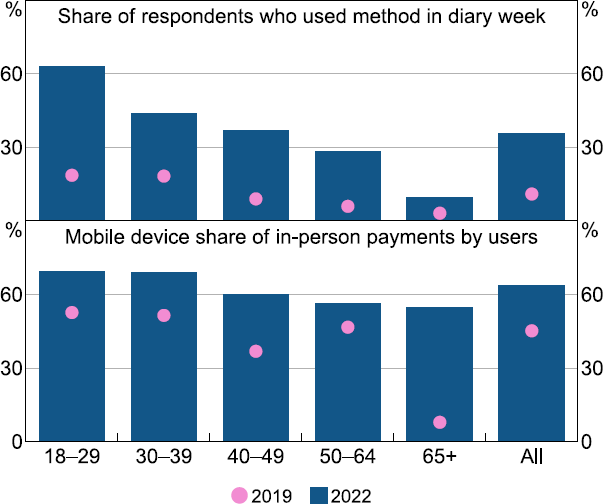
Note: Only includes respondents that made mobile device payments at least once in the diary week.
Source: RBA calculations, based on data from Ipsos and Roy Morgan Research.
In addition to the diary data, all respondents were asked if they stored each of their payment cards in a mobile wallet (such as Apple Wallet, Google Wallet, Samsung Wallet etc). Around half of respondents stated that they had a card stored in a mobile wallet in 2022, with younger people reporting the highest shares (Figure 24, top panel). Mobile wallets have become more popular for consumers of all age groups since 2019 (Figure 24, bottom panel). Having a single card stored in a mobile wallet is more common than having multiple cards stored. Nearly 90 per cent of CPS respondents indicated that they were at least aware of the ability to make contactless payments via a payments-enabled mobile device.
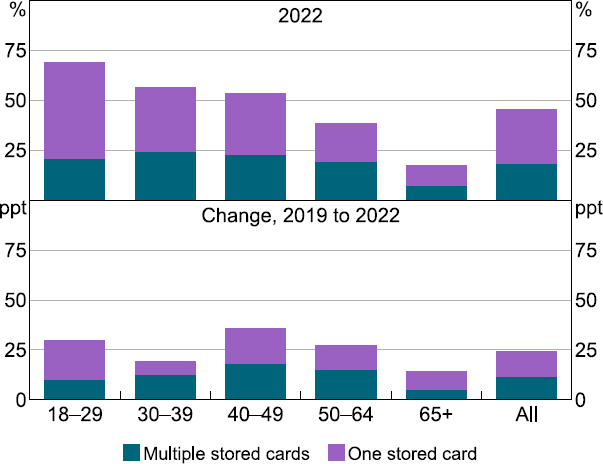
Source: RBA calculations, based on data from Ipsos and Roy Morgan Research.
Australia has adopted contactless payments earlier and reached near universal uptake before some other countries (Figure 25). Besides consumer demand for convenience, the rise of contactless payments in Australia has been strongly supported by the fast rollout of contactless-enabled cards and terminals by card schemes, card issuers and payment service providers. Early adoption by the hospitality industry and large merchants such as supermarkets and department stores also facilitated consumer uptake. As discussed earlier, the pandemic also spurred greater use of electronic payments, including contactless payments.
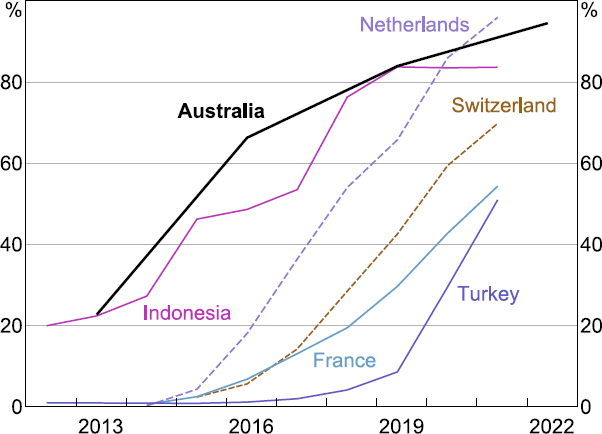
Note: Observations are not directly comparable due to differing survey methods and inclusions across economies.
Sources: BIS; RBA calculations based on data from Colmar Brunton, Ipsos and Roy Morgan Research.
5.4 Surcharging of card transactions
To recover the cost of accepting card payments, a merchant may apply an additional fee, or surcharge. The Reserve Bank first enacted rules in 2003 to require card schemes to remove their ‘no-surcharge’ rules, thereby freeing merchants to surcharge card payments. The Reserve Bank's rules are aimed at supporting the efficiency of the payments system, by ensuring that consumers are encouraged to use the lowest cost payment instrument. Changes to the Reserve Bank's surcharging rules were made following a review in 2015–2016, which reduced the allowed size of surcharges levied by merchants in some industries.
The survey showed that the frequency of surcharging increased from 2019 to 2022. CPS participants reported that a surcharge was paid on 7 per cent of card transactions in 2022 (Table 4), up from around 5 per cent of card transactions in 2019. When measured as a percentage of the transaction value, the median surcharge reported was 1.5 per cent, which was 50 basis points lower than three years earlier. In value terms, the median surcharge declined from 80¢ to 50¢.[14] The reduction in median surcharges is consistent with the increased use of cards for lower-value purchases between 2019 and 2022, as well as the decline in the average cost of card payments.
In past surveys, a number of factors were associated with whether a surcharge was paid by consumers, such as the type of card used and the environment in which the payment was made (e.g. online or in person). However, these factors appear to have diminished in importance in the latest survey. For instance, in the 2022 CPS surcharges were paid equally as often on credit card and debit card payments (Table 4); in previous years, credit card payments were surcharged more often. The increased prevalence of debit card payments, greater use of payment plans that charge merchants a single percentage rate for accepting all card types, and the emergence of payment providers that offer automatic surcharging may have all contributed to the convergence in surcharging frequency on credit and debit cards. Similarly, while online payments continued to be surcharged more frequently than in-person payments, the difference in frequency was narrower than in past surveys. Consumers who held a credit card that offered rewards points – which tend to be relatively expensive for merchants to accept – were more likely to have paid a card surcharge than those who owned a non-rewards credit card; however, once again the difference was smaller than in past surveys.
| 2019 | 2022 | |
|---|---|---|
| All card payments | 4.7 | 7.3 |
| Credit cards | 5.5 | 7.3 |
| Debit cards | 4.3 | 7.3 |
| Reward cardholder status | ||
| Owns a rewards card | 5.3 | 7.5 |
| Does not own a rewards card | 3.7 | 6.6 |
| By payment channel | ||
| In-person | 4.0 | 7.1 |
| Online | 9.2 | 8.5 |
|
Notes: Excludes payments over $9,999, transfers (payments to family and friends) and automatic payments. Numbers published in Caddy et al (2020) differ because of data cleaning approach. Source: RBA calculations, based on data from Ipsos and Roy Morgan Research. |
||
Respondents were also asked about their typical response when they discover that a merchant levies a surcharge on some payment methods. Around 45 per cent of consumers said they would choose a non-surcharged method when faced with a surcharge (Figure 26). This level indicates that there is some scope for merchants to encourage consumers to switch to a different, lower-cost payment method by applying a surcharge on certain payments. Nonetheless, in 2022 a greater share of respondents reported being likely to accept surcharges than in 2019. The increased acceptance of surcharges by consumers may reflect the fact that fewer consumers carried a non-surcharged payment method such as cash. Around 20 per cent of consumers would avoid shopping at a merchant that levies a surcharge. This possibility of losing customers helps explain why many merchants choose not to apply a surcharge on card payments.
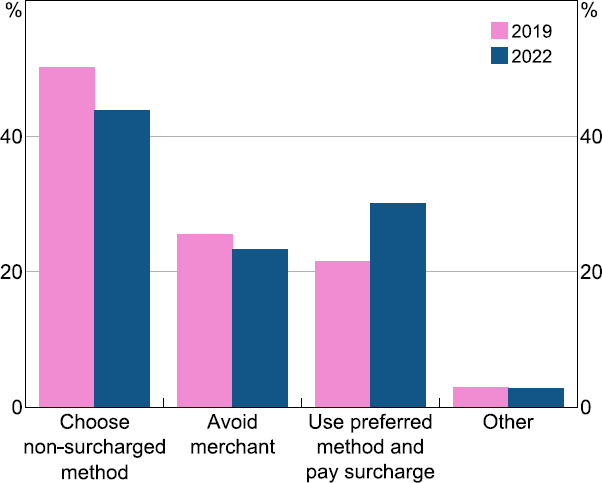
Source: RBA calculations, based on data from Ipsos and Roy Morgan Research.
5.5 Dual network debit cards
In the 2022 CPS the Reserve Bank included some new questions to gauge consumer awareness of dual network debit cards (DNDCs). These questions will help inform policy as the Reserve Bank seeks to increase competition and reduce costs in the debit card market.
DNDCs, also called ‘co-badged’ or ‘multi-network’ cards, have access to two debit payment networks on the one card. In Australia, DNDCs typically have access to the domestic debit network – eftpos – and one of the international debit networks such as Visa or Mastercard. In Australia, 85 per cent of debit cards are DNDCs, with the remainder being single network debit cards. DNDCs give consumers the ability to make transactions on either network where it is available. For instance, a consumer travelling overseas could use the international network on their card, while in Australia they could use either the eftpos network or the international network. The Reserve Bank supports the issuance of DNDCs to provide effective competition between networks, which can put downward pressure on fees for merchants and consumers.
There are three main ways the network on a DNDC can be chosen to make a payment. First, a default network can be set by the issuer of the card, and this might be influenced by rules set by the card schemes. For example, for contactless payments, DNDCs are currently set to default to the international network. Second, the merchant could have least-cost routing (LCR) enabled. This lets merchants choose to override the default network for contactless payments. Merchants may want to choose the network because one network on a DNDC could be cheaper for the merchant to accept than the other. Third, the consumer could choose the network, for example by inserting the card at a terminal and selecting from an on-screen option. Consumers may have a range of reasons for wanting to choose the network, including to avoid or reduce a surcharge (which can vary by network).
In recent years, the Reserve Bank has encouraged the rollout of LCR. This functionality gives merchants the ability to set up rules ahead of time to choose the lowest-cost payment network for a particular contactless or online payment made using a DNDC. LCR can lower merchants' payment costs and encourages competition in the debit card market. But it means that consumers may not know which network on their card will be used to make a payment. By gauging consumer awareness of DNDCs the Reserve Bank can understand more about the costs and benefits of providing consumer choice and the factors driving consumers' choices.
In the 2022 CPS, the Reserve Bank asked five questions about DNDCs: one in the pre-diary and four in the post-diary questionnaire. The original survey questions are more detailed than the paraphrased questions and responses used in the material below. The full questions did not assume much knowledge of the debit card market nor use the terminology ‘dual network debit card’, see Appendix A.3 for the full wording of questions.
The first question gauged consumers' knowledge of whether they had a DNDC. Before a consumer can choose the network on their DNDC they must first know they own a debit card with more than one network. This question was only given to the 93 per cent of consumers who owned a debit card. The first question was specifically worded to get consumers to answer using their existing knowledge, not to get them to check their cards or investigate further. Just over 40 per cent of consumers said they knew that they had a DNDC, just under 40 per cent were unsure, and the remainder said they did not have a DNDC (Figure 27).
The large share of consumers that were not sure that they had a DNDC highlights the lack of general consumer knowledge of DNDCs. This could partly reflect the rise of contactless payments, where DNDC payments are routed without consumers making an active choice, resulting in less consumer engagement with their options. Consumer awareness of the second network on DNDCs may also be inhibited by the front of the card typically just showing the international network's logo, with the eftpos logo displayed on the back of the card.
While just over 40 per cent of consumers said they knew that they had a DNDC, this could overstate consumer awareness for a few reasons. First, the question came after consumers were asked whether they had a debit or credit card and what specific cards they owned; some consumers may have inadvertently checked their cards when answering those questions. Second, while consumers were asked not to check their debit cards to see if they had a DNDC, some may have intentionally done so anyway. Third, respondents to the survey may be more engaged with payments than the average consumer, since they agreed to complete a payments survey. Working in the other direction, some consumers may have been confused by the terminology used in the survey and may have been aware of the type of debit card they owned.
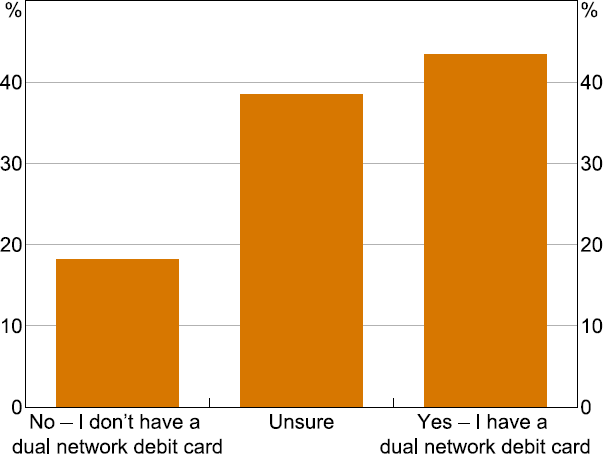
Note: Share of respondents with at least one debit card answering the question ‘Off the top of your head, do you know if you have a debit card that can process payments through more than one network?’.
Source: RBA calculations, based on data from Ipsos.
To assess the actual rate of DNDC ownership, in the post-diary questionnaire consumers were given specific instructions on how to check their cards. After being presented with these instructions, just under 90 per cent of consumers reported having a DNDC (Figure 28). This is close to the system-wide average of 85 per cent of Australian debit cards being dual network, and suggests that consumers were able to accurately determine if their cards were dual network. Comparing the results of the pre-diary with the post-diary questions shows that there were often significant differences in consumers' answers to the two questions. For instance, over three-quarters of those that initially said they did not have a DNDC, said after inspecting their cards that they did have a DNDC. In total, just over 55 per cent of consumers were either initially unsure or incorrect about whether they had a DNDC. This again highlights consumers' general lack of knowledge about DNDCs.
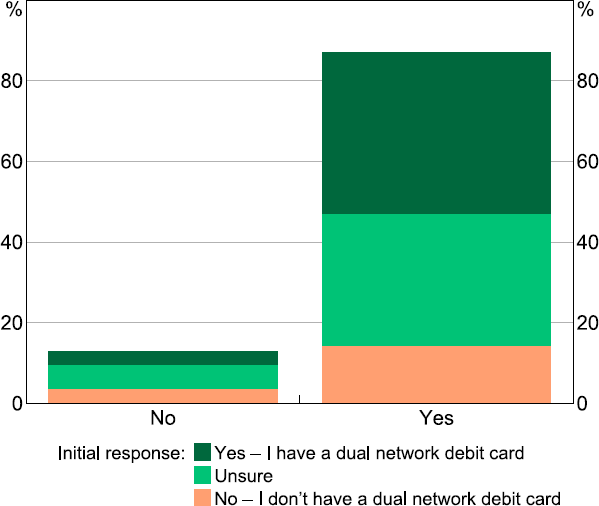
Note: Share of respondents with at least one debit card answering the question ‘Check your debit card(s), do you have a debit card that has both the logo of one of the international networks on the front and the eftpos logo on the back?’.
Source: RBA calculations, based on data from Ipsos.
To gauge consumers' desire to choose the network on their DNDC, they were then asked whether it mattered to them which network on their card processed their transactions. Most consumers reported that it did not matter to them which network on their card processed their transactions, with just under one-fifth of consumers reporting it did matter (Figure 29). The high share of consumers that said it did not matter to them may reflect an assessment that there are limited benefits to gain from choosing one network over another or a lack of awareness of the differences. In general, benefits or rewards for using a specific debit network are rare, although some merchants may charge a lower surcharge for some networks, and some networks may have stronger protections or better refund/chargeback processes.
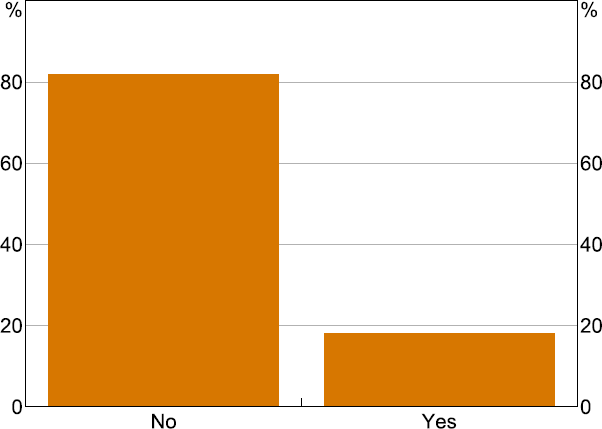
Note: Share of respondents with at least one dual network debit card answering the question ‘Thinking about your ATM/debit card(s) that has more than one network, does it matter to you which network on your card(s) processes your transactions?’.
Source: RBA calculations, based on data from Ipsos.
Consumers were then asked whether they favoured a particular network. Among the one-fifth of debit card owners that had a preference, broadly similar shares preferred eftpos, Visa and Mastercard (Table 5). While eftpos was the single most chosen network, consumers do not get to choose between all three networks at the same time; instead they choose between eftpos and Visa, or between eftpos and Mastercard. As a group, the international schemes were more favoured by consumers than eftpos.
Finally, to assess influences that would drive consumers to choose one network over another, they were asked to choose the factors that guided their choice of network. The main reasons stated for preferring one network over another were the perceived safety/security of a transaction, surcharges, merchant acceptance and speed of transaction (Table 5). Few consumers reported choosing debit networks based on reward points or additional warranties.
Overall, these results suggest that consumers have low awareness of DNDCs and showed that only a small share of consumers cared which network processed their debit transactions.
| All DNDC holders (%) |
DNDC holders that have a preferred network (%) |
|
|---|---|---|
| Does not matter which network processes transactions | 82 | na |
| Have a preferred network | 18 | 100 |
| eftpos | 7 | 39 |
| Visa | 5 | 30 |
| Mastercard | 5 | 27 |
| Other | 1 | 4 |
| Factors that influence preferred network(a) | ||
| Safety/security of the transaction | 11 | 59 |
| Surcharges for making the payment | 8 | 46 |
| Greater acceptance by merchants | 8 | 42 |
| Transaction speed | 6 | 35 |
| Better fraud/chargeback protections | 6 | 32 |
| Reward points | 4 | 21 |
| Additional warranty and/or insurance | 2 | 10 |
| Other | 0 | 2 |
|
Note: (a) Factors do not sum to above totals because consumers could pick more than one factor. Source: RBA calculations, based on data from Ipsos. |
||
6. Online and Automatic Payments
6.1 Online
Online payments made up a higher share of retail payments in 2022 than in 2019, with consumers shifting away from in-person transactions. When measured by the number of transactions, the share of payments made online was 18 per cent – up from 13 per cent in 2019 and just 4 per cent in 2007 (Table 6). This reflects the long-term rise in e-commerce, spurred on more recently by lockdowns and social distancing during the pandemic.
Around two-thirds of respondents made at least one online payment in 2022, up from around 55 per cent in 2019 and more than double the share of people surveyed in 2007. Some goods or services are more difficult or more expensive to purchase online – including petrol, supermarket items and food retail – and so only a small share of these purchases are made online (Figure 30). For other types of services – such as leisure, bills and holidays – a high share of purchases are made online. More than half of leisure purchases – such as music, movies and sports tickets – were made online in 2022.
| 2007 | 2010 | 2013 | 2016 | 2019 | 2022 | |
|---|---|---|---|---|---|---|
| Online payments as a share of consumer payments(a) | ||||||
| Number | 4 | 7 | 13 | 13 | 13 | 18 |
| Value | 13 | 26 | 36 | 39 | 35 | 40 |
| Mobile/app as a share of online payments(b) | na | na | 6 | 20 | 40 | 37 |
| Online and automatic payments as a share of total spending(c) | ||||||
| Number | na | na | 16 | 19 | 21 | 29 |
| Value | na | na | 44 | 48 | 49 | 60 |
|
Notes: Numbers published in Caddy et al (2020) differ because of data cleaning approach.
Source: RBA calculations, based on data from Colmar Brunton, Ipsos and Roy Morgan Research. |
||||||
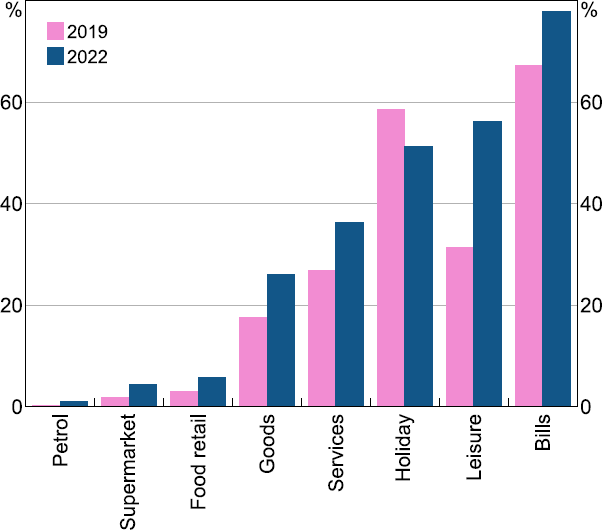
Source: RBA calculations, based on data from Ipsos and Roy Morgan Research.
Consumers are increasingly using their debit cards to make online payments, in addition to BPAY and bank transfers which have historically accounted for the largest share of online payments. In 2022, the share of online payments made using mobile apps was little changed from 2019 at just under 40 per cent, with the remainder initiated through other means such as web browsers (e.g. Chrome or Safari).
The figures for online payments as a share of consumer payments shown in Table 6 do not include participants' automatic payment arrangements (e.g. direct debits), which are recorded separately in a post-diary questionnaire (see Section 6.2 below). When these automatic payment arrangements are included in total spending, the share of total weekly spending accounted for by automatic and online payments has increased by 11 percentage points since 2019 (Table 6).
Online payments continue to be made most frequently by younger respondents. Three-quarters of people aged under 40 made at least one online payment during the 2022 diary week (Figure 31, top panel). The online payment users in this age group made nearly one-third of their weekly purchases online on average, more than half of the time via mobile apps (Figure 31, bottom panel). When respondents in older age groups made online purchases, they tended to use apps less frequently.
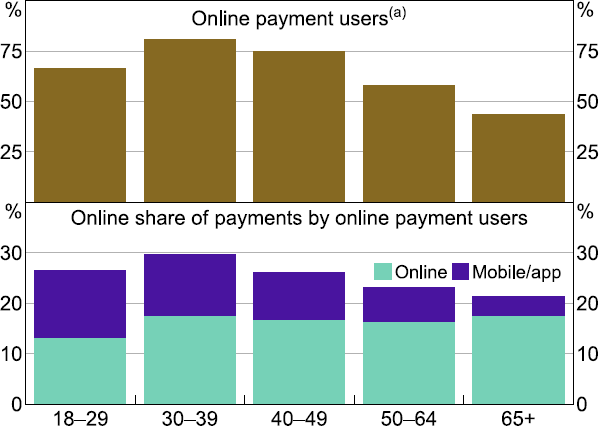
Note: (a) Share of respondents who made at least one online payment in the diary week.
Source: RBA calculations, based on data from Ipsos.
6.2 Automatic payments
In addition to recording payments that they initiated during the diary week, respondents were asked details about automatic payments that occurred during the week as part of a post-diary questionnaire. These automatic payments include pre-authorised direct debit payments for bills (e.g. rent, phone and utility bills or digital service subscriptions), regular debt repayments (mortgage or credit card repayments) and recurring ‘pay anyone’ transactions set up via internet banking.
Automatic payment arrangements are becoming more common, with 83 per cent of respondents in 2022 reporting that they had at least one automatic payment arrangement, compared with 65 per cent in 2016. The share of payments made automatically during the week of the CPS has been steadily increasing over recent years, to 12 per cent of the total number of transactions (Figure 32, left panel). By value, nearly one-third of weekly spending was made automatically in 2022 (Figure 32, right panel). The growth in automatic payments reflects the changing way people pay their bills as well as the increasing use of subscription services, such as video streaming and meal services. Two-thirds of all household bill payments in 2022 were made automatically, which is around triple the share in 2013. This shift towards automatic payments for certain transactions is another way in which payments are becoming more convenient for consumers.
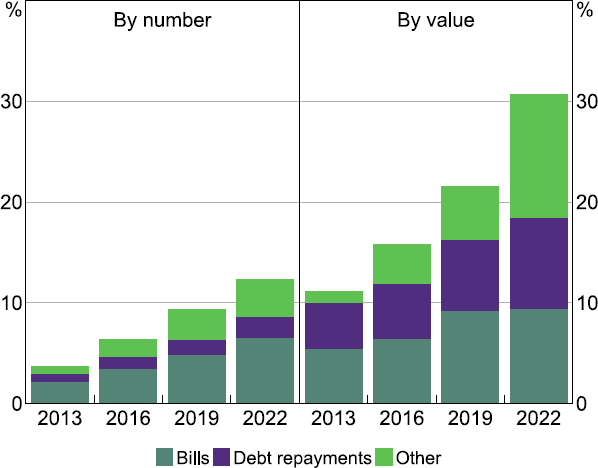
Source: RBA calculations, based on data from Colmar Brunton, Ipsos and Roy Morgan Research.
7. Cheques
Just seven personal cheque payments were recorded in the 2022 CPS, accounting for only 0.1 per cent of the number of payments. This was down from 1.2 per cent of payments in 2007.
As in previous surveys, the use of cheques was heavily concentrated among older Australians. The share of respondents over 65 that had made a cheque payment in the past year was nearly triple that of those under 65, at 14 per cent versus 5 per cent. One-quarter of respondents aged 65 and above owned a cheque book, while less than 2 per cent of respondents under 30 had a cheque book (Figure 33).
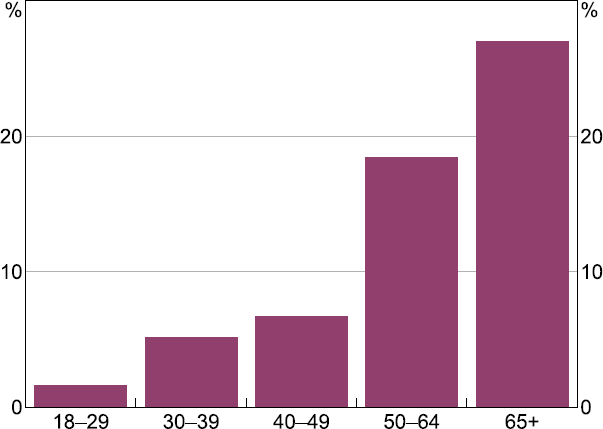
Source: RBA calculations, based on data from Ipsos.
Just 1 per cent of respondents said they would experience a ‘major inconvenience’ or ‘genuine hardship’ if shops and businesses stopped accepting cheques for payments. The Australian Government has outlined plans to wind down the cheque system by 2030 (Australian Government 2023). The results from the 2022 CPS suggest this will only affect a small share of the population, with this group more likely to be over 65. The widespread increase in card payments seen in the 2022 survey shows a large share of older consumers have already adapted to changing payment methods. Nevertheless, the payments industry, including banks, will need to work with cheque users to help them transition to different payment methods.
8. Other Payment Methods
8.1 Consumer awareness and use
In recent years, several other ways to make payments – besides cash, cards or cheques – have emerged in Australia. The CPS gathered respondents' knowledge and usage of a number of these other ways to make payments. Knowledge and usage of these different payment methods varied widely among respondents (Figure 34). PayPal, a type of digital wallet, and BNPL had near universal consumer awareness. In contrast, consumers had little awareness of Beem (a digital wallet with the ability to split money with friends) and Alipay/WeChat Pay (mobile payment services), and usage in Australia was also low. Many people were aware of cryptocurrencies, but only a very small share had used them to make a payment in the past year.
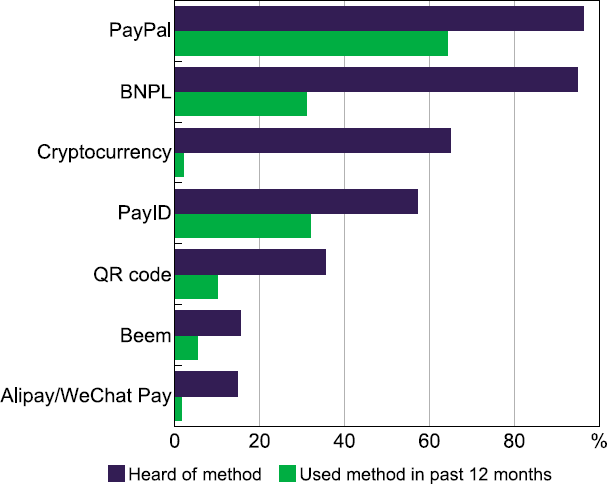
Source: RBA calculations, based on data from Ipsos.
The 2022 CPS asked respondents for the first time about their awareness of using quick-response (QR) codes for making payments. Some merchants now offer QR codes that direct consumers to a mobile wallet, typically funded by the consumer's debit or credit card, to complete a payment at the terminal. About one-third of respondents had heard of this payment method and around 10 per cent reported using it to make a payment in Australia in the past year. In some other countries, merchants are providing QR codes that allow their customers to pay by transferring funds directly from their bank account through fast payment systems. Adoption of this payment method in Australia could provide consumers with an alternative to card payments.
If participants in the CPS had heard of but not used an alternative payment method, they were asked about their reasons for not using it. Most of these respondents reported that their existing payment methods met their needs. For example, 50 per cent of people who were aware of BNPL said their existing methods met their needs; concerns about privacy and/or security and spending control were other commonly cited reasons for not using BNPL (Figure 35). Those who had not used cryptocurrency or QR code payments were relatively more likely to cite a lack of knowledge or tools, as well as concerns about privacy and/or security.
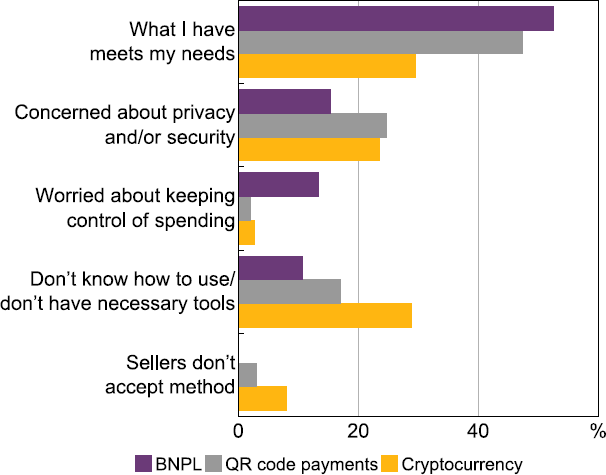
Note: Bars do not sum to 100 per cent as respondents could choose more than one answer and response of ‘Other reason’ not shown.
Source: RBA calculations, based on data from Ipsos.
8.2 Cryptocurrency payments
While only just under 2 per cent of respondents had used cryptocurrency to make a payment in the past year, 11 per cent of consumers reported holding cryptocurrency.[15] Males, especially those under 30, were the most likely to hold cryptocurrency (Figure 36). Even among males under 30 that held cryptocurrency, only a small share had made a payment using cryptocurrency in the past year. The low share of holders that had made a payment with cryptocurrency may reflect the large transaction fees for cryptocurrency transactions as well as little merchant acceptance in Australia. In addition, holders of cryptocurrency may be more driven by a desire for investment returns or hedging against inflation rather than using it as a payment method (Weber et al 2023).
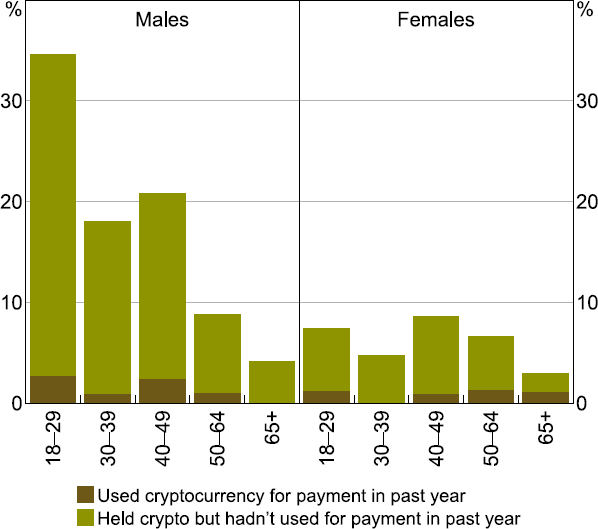
Source: RBA calculations, based on data from Ipsos.
8.3 Buy now, pay later
BNPL services allow customers to purchase goods on credit and make interest-free instalment repayments. While offering benefits for consumers, BNPL services are typically an expensive way for merchants to accept payments, costing on average around 4 per cent of the value of the transaction, compared with an average of around 0.5–1.5 per cent for traditional card payments. Almost one-third of Australians had used a BNPL service in the past year, up around 8 percentage points from 2019. Usage was highest among younger Australians: over 40 per cent of 18–39 year olds had used a BNPL service in the past year, compared with only 10 per cent for those aged 65 and over (Figure 37). Usage increased across all age groups from 2019. While a large share of Australians had used BNPL in the past year, BNPL payments made up just 0.7 per cent of the number of payments in 2022 up from 0.5 per cent in 2019.
Credit cards and BNPL services both allow customers to purchase goods on credit, and some consumers may use BNPL services as a substitute for credit cards. For instance, consumers that use BNPL are less likely to own a credit card, and this is true across most age groups (Figure 38). This may partly reflect that consumers who are not eligible for a credit card may use a BNPL service instead. In contrast to credit card issuers, BNPL services have not typically conducted thorough assessments of creditworthiness such as checking customers' incomes, assets and expenses.
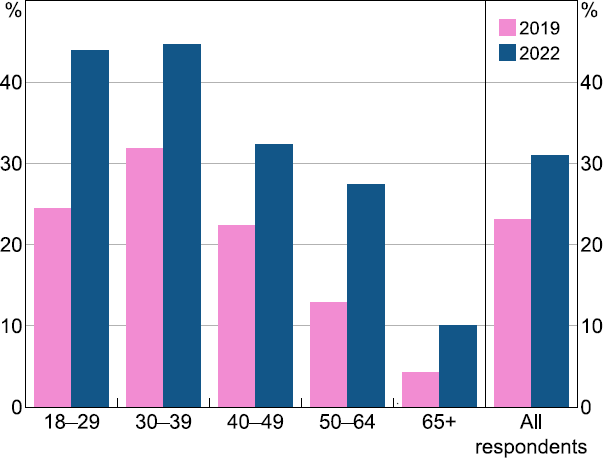
Source: RBA calculations, based on data from Ipsos and Roy Morgan Research.
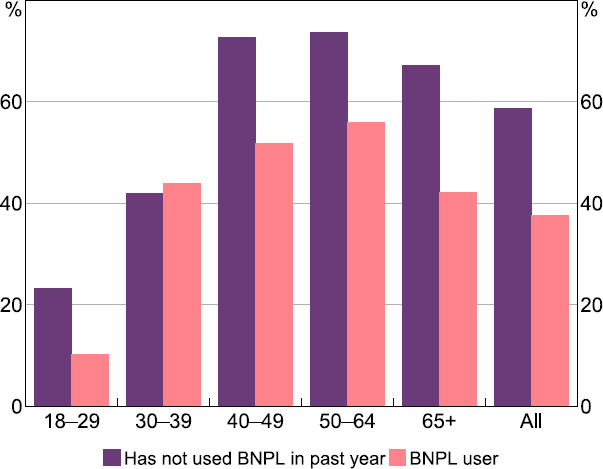
Source: RBA calculations, based on data from Ipsos.
For the first time, the 2022 CPS also collected data on the number of BNPL accounts consumers had with different BNPL providers. On average, Australians had 0.7 BNPL accounts per person, with people aged 18–39 having nearly one account on average (Figure 39, left panel). Those aged 65 and over were the least likely to hold a BNPL account. Of those consumers with a BNPL account, BNPL users held two accounts on average (Figure 39, right panel). Consumers with access to multiple accounts may encourage competition in the BNPL market, as providers compete to entice consumers to use their service. However, BNPL firms typically do not allow merchants to pass on the high cost of accepting their service directly to BNPL users through a surcharge. So, the benefits of competition in the BNPL market may accrue to BNPL users, subsidised by non-users as merchants recoup the cost by raising the price of goods and services generally.
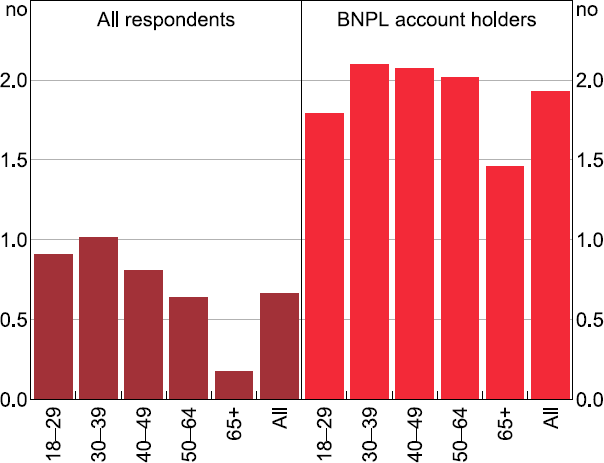
Source: RBA calculations, based on data from Ipsos.
8.4 Account-to-account payments, PayID and digital wallets
The way in which people can make account-to-account payments has changed significantly because of the introduction of new technologies. Since its launch in February 2018, the NPP has allowed customers of more than 90 financial institutions to make fast data-rich payments 24 hours a day; over 88 million Australian bank accounts are able to make and/or receive payments through the NPP (NPP Australia 2022). Separately, mobile apps have been developed to facilitate quick and easy transfers to friends and family (e.g. Beem) and even provide pocket money.
A significant innovation of the NPP has been the introduction of PayID. It allows account-to-account bank transfers to be addressed using a mobile number, email address or Australian Business Number (ABN). In 2022, around half of Australians had heard of PayID and 30 per cent had used it in the past year (Figure 34). PayID is more convenient than using the traditional Bank State Branch (BSB) and account numbers, which require consumers to correctly key in 15 digits. Another benefit of PayID is that the payer receives confirmation of the name of the person or business being paid, reducing the risk of fraud. PayID was introduced in 2018 as part of the NPP. Consumer uptake of PayID has been slower than initially expected, and currently not all Australian bank accounts are connected to make or receive a payment using PayID (Connolly 2022). In the diary, payments using PayID made up around 10 per cent of bank transfers, with the remainder addressed using BSB and account numbers (Figure 40). Consumers under the age of 50 had the highest share of bank transfers addressed using PayID.
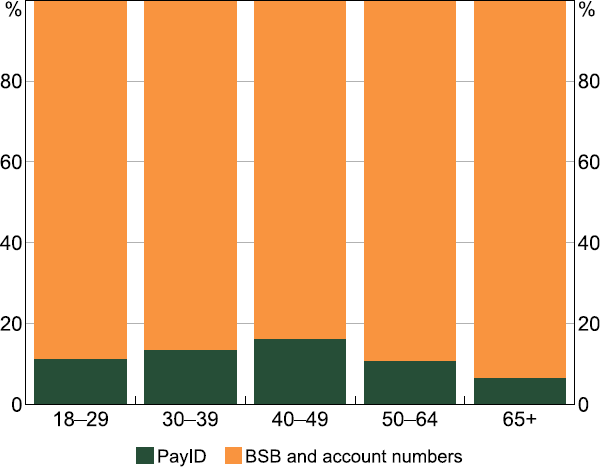
Note: Excludes transfers to family and friends, and transfers within own accounts.
Source: RBA calculations, based on data from Ipsos.
Among consumers that had heard of PayID but not used it in the past year, most felt that their existing payment methods met their needs (Figure 41). Some respondents also didn't know how to use or didn't have the necessary tools to use PayID. This could reflect that some institutions have not yet rolled out PayID. Among institutions that had rolled out PayID, many do not advertise the benefits to their customers or give much guidance on how to use PayID.
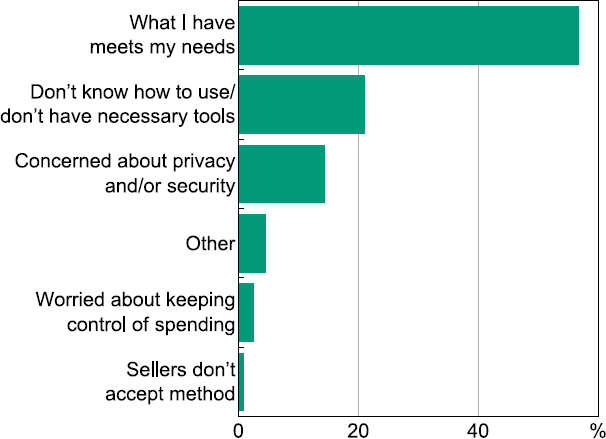
Source: RBA calculations, based on data from Ipsos.
New payment technologies have also facilitated a shift to transferring money to family and friends electronically using mobile apps rather than providing cash. The overall number of peer-to-peer transfers has been steady at around 2 per cent of consumer payments since 2013. The share of these transfers made using mobile and app-based methods has been steadily rising and accounted for over half of transfers in 2022 (Figure 42).[16] The increase in the use of mobile technology for transfers has been led by younger age groups, with respondents aged under 30 making three-quarters of their peer-to-peer transfers using apps.
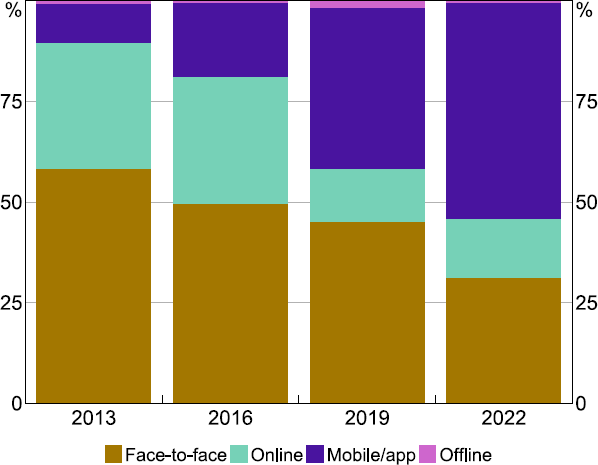
Source: RBA calculations, based on data from Colmar Brunton, Ipsos and Roy Morgan Research.
8.5 Transport cards
Since the 2019 survey, the CPS has collected information on the use of pre-paid transport cards such as Myki and Opal.[17] These types of cards have been rolled out across many public transport systems in Australia. More recently some public transport terminals have enabled fares to be paid directly by tapping a debit or credit card or mobile device on the terminal rather than a specific transport card. In the interest of ensuring comparability with previous survey waves, the analysis in the preceding sections does not include payments made with transport cards. In 2022, these payments were equivalent to 0.7 per cent of the number of consumer payments, down from 2 per cent in 2019. Besides increased use of payment cards and mobile devices directly on public transport terminals, the decline in transport card use may have been caused by increased working from home following the pandemic. For instance, usage of public transport in Australia was below pre-pandemic levels in 2022 (see Nicholas (2023) or Roy Morgan (2023)).
Appendix A: Survey Methodology
The fieldwork for the 2022 CPS was conducted by the research firm Ipsos on behalf of the Reserve Bank between October and early December 2022. The survey consisted of three parts: a pre-diary questionnaire about the demographic characteristics of respondents; a seven-day payments diary; and a post-survey questionnaire about respondents' automatic payment arrangements and their preferences and attitudes about different payment methods. To encourage participation and engagement with the survey, respondents received a gift card worth $100 on completion of the three components.
The survey was delivered online for most respondents but to ensure the sample was broadly representative of the Australian population, participants without internet access were recruited by telephone to complete a paper-based survey. The overall response rate was down slightly from 2019, resulting in a final sample of 999 respondents (Table A1). Respondents recorded a total of around 13,000 transactions in the survey, comprising day-to-day payments, transfers to family or friends, automatic payments and cash top-ups (Table A2).
| Number recruited | Number of completed responses | Response rate (%) | |
|---|---|---|---|
| Online respondents | 1,800 | 943 | 52 |
| Offline respondents | 103 | 56 | 54 |
| Total | 1,903 | 999 | 52 |
|
Source: RBA calculations, based on data from Ipsos. |
|||
| Number | Value ($) | |
|---|---|---|
| Day-to-day payments | 10,422 | 1,368,521 |
| Transfers and cash deposits | 415 | 168,698 |
| Automatic payments | 1,857 | 512,165 |
| Cash top-ups | 421 | 132,041 |
| Total | 13,115 | 2,181,425 |
|
Source: RBA calculations, based on data from Ipsos. |
||
A.1 Survey instruments
Pre-diary questionnaire
The demographic information collected in the pre-diary questionnaire was mostly the same as that collected in 2019. Demographic variables included age, sex, personal and household income, family composition, household size, location (capital city or rest of state), employment status, occupation, education level and whether respondents experienced any disabilities. A full list of debit and credit cards held by the respondent was collected, with the respondent also identifying their primary debit and credit card. Respondents also provided information about how they usually paid off their credit card debt (i.e. whether they paid off their debt every month or whether they let part of the balance roll over from month to month).
Payments diary
The payments diary was similar to that used in 2019 to ensure comparability of data across surveys. In the diary, respondents recorded details about every transaction they made for a week, excluding automatic payments (which were recorded in the post-survey questionnaire). These details included the value, payment method, payment channel and type of merchant. The payment methods and channels that respondents chose from were modified from 2019 to better match the ways that people pay – for example, bank transfers were split between using PayID and BSB and account numbers. For card transactions, online respondents selected the specific card they used (from the list of cards they provided in the pre-diary questionnaire); offline participants only recorded the type of card they used (e.g. debit card, Visa/Mastercard credit card). Respondents also recorded the dollar value or percentage amount of any payment surcharges that they paid. Along with their payments, respondents were asked to include details of cash top-ups, including the value of any ATM fee paid. The full list of fields used in the 2022 diary is set out in Table A3.
Post-survey questionnaire
In the post-survey questionnaire, respondents were asked to record details of any automatic payments that occurred during the diary week, referring to their latest bank statements.
In 2022, qualitative questions in the post-survey questionnaire focused on consumers' preferences and attitudes towards different payment methods. Key topics included use of and reliance on cash, payment preferences in different environments, awareness and use of new payment methods (such as BNPL services) and perceptions around privacy in payments. In addition, there were questions looking at respondents' knowledge of dual network debit cards and two discrete choice experiment style questions about the cash system.
| Payments | |
|---|---|
Date Day-of-week Payment amount Payment surcharge paid (dollar/per cent amount) Payment method:
Payment channel: In person
Not in person
|
Payment purpose:
|
| Cash top-ups | |
Date Day-of-week Cash top-up amount ATM fee paid (dollar amount) Total value of banknotes in wallet after top-up |
Source of cash:
|
| Note: (a) Online respondents selected the specific card they used (from the list of cards they provided in the pre-diary questionnaire); offline respondents selected from: debit card, MasterCard/Visa credit card, American Express/Diners Club, or another credit card. | |
A.2 Survey sample and weighting
The overall sampling process for the 2022 CPS was similar to that used for the 2019 survey. To ensure the survey sample was broadly representative of the Australian population, there were minimum recruitment targets covering key demographic variables: age; sex; household income; location (i.e. capital city or rest of state); credit card ownership; and household internet access (including access to the internet using a mobile phone). Recruitment targets for most demographic variables were based on data from the Australian Bureau of Statistics (ABS); data on credit card ownership and household internet access were obtained from the Household, Income and Labour Dynamics in Australia (HILDA) Survey Release 20.0. Data on use of mobile phones to access the internet was based on Australian Communications and Media Authority's ‘How we use the internet’ data. Minimum targets were based on a sample size of 1,000 respondents.
Recruitment for the survey commenced on Monday, 17 October 2022 using Computer Assisted Telephone Interviewing. Most recruits were obtained by Friday, 11 November 2022; subsequent recruitment ensured each minimum recruitment target was met. Ipsos used a combination of automated email/SMS reminders and ad hoc contacts to support completions of the survey.
Due to different response rates across the demographic categories for which recruitment targets were set, we constructed survey weights so that the final (weighted) dataset aligns with population benchmarks. Weighting ensures that the survey data can be used to make inferences about the Australian population. We used the iterative proportional fitting procedure, or raking, to calibrate the survey weights; the same procedure was used for the 2016 and 2019 CPS, though we used R instead of Stata for all analysis. We implemented the raking algorithm using the ‘ipf’ function in the ‘surveysd’ package in R. Table A4 presents the unweighted sample distribution for selected demographic variables, alongside the population distribution and the mean weight for respondents in each group.
| Unweighted sample proportion (%) |
Population proportion (%) |
Mean weight | |
|---|---|---|---|
| Age(a) | |||
| 18–24 | 12 | 11 | 0.90 |
| 25–34 | 16 | 18 | 1.13 |
| 35–44 | 17 | 18 | 1.06 |
| 45–54 | 16 | 16 | 1.00 |
| 55–64 | 13 | 15 | 1.18 |
| 65+ | 26 | 22 | 0.84 |
| Gender(a) | |||
| Female | 54 | 51 | 0.95 |
| Male | 46 | 49 | 1.06 |
| Location(a) | |||
| Regional | 38 | 33 | 0.87 |
| Capital city | 62 | 67 | 1.08 |
| Household income quartile(a),(b) | |||
| 1st | 26 | 24 | 0.93 |
| 2nd | 25 | 26 | 1.05 |
| 3rd | 24 | 24 | 1.01 |
| 4th | 26 | 26 | 1.01 |
| Credit card ownership(c) | |||
| Yes | 60 | 52 | 0.86 |
| No | 40 | 48 | 1.20 |
|
Notes:
Source: RBA calculations, based on data from ABS, HILDA and Ipsos. |
|||
A.3 Dual network debit card questions
These are the full questions that respondents answered relating to dual network debit cards.
Pre-diary questionnaire
B4 Off the top of your head do you know if you have an ATM/debit card that can process payments through more than one network? (e.g. eftpos, Mastercard, Visa, Unionpay)
Please do not check your ATM/debit cards when answering this question. For this question we are interested in what you know about your cards, not what you actually have.
Post-diary questionnaire
Q7.7 Please check the ATM/debit cards that you own.
Do you have an ATM/debit card that has both the logo of one of the international networks on the front (e.g. Mastercard, Visa, Unionpay) and has the eftpos logo on the back?
On the front of the card: Mastercard, Visa, UnionPay [logos shown]
On the back of the card: eftpos [logo shown]
Q7.8a Thinking about your ATM/debit card(s) that has more than one network (i.e. has the logo of an international network on the front and has the eftpos logo on the back) …
Does it matter to you which network on your card(s) processes your transactions? (e.g. eftpos, Mastercard, Visa, UnionPay)
Q7.8b Thinking about your ATM/debit card(s) that has more than one network (i.e. has the logo of an international network on the front and has the eftpos logo on the back)…
Which network do you prefer to process your transaction?
ⓘ Mark one response only
Q7.8c What factors influence your choice of the network to process your transactions?
ⓘ Mark all that apply
References
Australian Government (2022), ‘Budget Paper No 2: Budget Measures’, Budget October 2022–23, pp 158–159.
Australian Government (2023), ‘A Strategic Plan for Australia's Payments System: Building a Modern and Resilient Payments System’, Final report, June.
Bagnall, J, S Chong and K Smith (2011), Strategic Review of Innovation in the Payments System: Results of the Reserve Bank of Australia's 2010 Consumer Payments Use Study, Reserve Bank of Australia, Sydney.
Caddy J, L Delaney and C Fisher (2020), ‘Consumer Payment Behaviour in Australia: Evidence from the 2019 Consumer Payments Survey’, RBA Research Discussion Paper No 2020-06.
Connolly E (2022), ‘Real-time Payments in Australia’, Opening Address to the NPP Australia Real Time Payments Summit 21/22 ‘More than Just Speed’, Sydney, 3 May.
Doyle M-A, C Fisher, E Tellez and A Yadav (2017), ‘How Australians Pay: Evidence from the 2016 Consumer Payments Survey’, RBA Research Discussion Paper No 2017-04.
Gill T, C Holland and G Wiley (2022), ‘The Cost of Card Payments for Merchants’, RBA Bulletin, September.
Guttmann R, T Livermore and Z Zhang (2023), ‘The Cash-use Cycle in Australia’, RBA Bulletin, March.
McGrail MR and JS Humphreys (2015), ‘Spatial Access Disparities to Primary Health Care in Rural and Remote Australia’, Geospatial Health, 10(2), pp 138–143.
Mueller AL, MS McNamara and DA Sinclair (2020), ‘Why Does COVID-19 Disproportionately Affect Older People?’, Aging, 12(10), pp 9959–9981.
Mulqueeney J and T Livermore (2023), ‘Cash Use and Attitudes in Australia’, RBA Bulletin, June.
Nguyen T and B Watson (2023), ‘Consumer Payment Behaviour in Australia’, RBA Bulletin, June.
Nicholas J (2023), ‘New Normal? Sydney and Melbourne Public Transport Use Still at 80% of Pre-Covid Levels’, Datablog, The Guardian online, 13 March, viewed 20 September 2023. Available at <https://www.theguardian.com/news/datablog/2023/mar/13/new-normal-sydney-and-melbourne-public-transport-use-still-at-80-of-pre-covid-levels>.
NPP Australia (2022), ‘NPP Roadmap October 2022’.
Roy Morgan (2023), ‘Public Transport Use Increases in March Quarter 2023 – but Frequency of Use Is over 20% Lower than Pre-pandemic’, Finding No 9281.
Weber M, B Candia, O Coibion and Y Gorodnichenko (2023), ‘Do You Even Crypto, Bro? Cryptocurrencies in Household Finance’, NBER Working Paper No 31284.
Copyright and Disclaimer Notice
HILDA Survey Disclaimer Notice
This document uses unit record data from the Household, Income and Labour Dynamics in Australia (HILDA) Survey. The unit record data from the HILDA Survey was obtained from the Australian Data Archive, which is hosted by The Australian National University. The HILDA Survey was initiated and is funded by the Australian Government Department of Social Services (DSS) and is managed by the Melbourne Institute of Applied Economic and Social Research (Melbourne Institute). The findings and views based on the data, however, are those of the authors and should not be attributed to the Australian Government, DSS, the Melbourne Institute, the Australian Data Archive or The Australian National University and none of those entities bear any responsibility for the analysis or interpretation of the unit record data from the HILDA Survey provided by the authors.
Acknowledgements
We thank Troy Gill for his helpful advice and comments as well as valuable contribution to the planning, design and implementation of the survey. We would also like to thank Leon Berkelmans, Ellis Connolly, Rochelle Guttmann, Brad Jones, Michelle McPhee, John Simon and Chris Thompson for their helpful advice and comments. The views expressed in this paper are those of the authors and do not necessarily reflect the views of the Reserve Bank of Australia. The authors are solely responsible for any errors.
Footnotes
Note Issue Department [*]
Payments Policy Department [**]
For a discussion of the 2017 and 2019 CPS results, see Doyle et al (2017) and Caddy, Delaney and Fisher (2020). This discussion paper builds on material released in the June 2023 Bulletin, see Mulqueeney and Livermore (2023) and Nguyen and Watson (2023). [1]
Differences in survey design and coverage mean that the results of these surveys are not fully comparable. See Bagnall, Chong and Smith (2011) for an earlier discussion of the results of harmonised payment survey data. [2]
Governments and central banks in some countries – such as the Netherlands, Norway and the United Kingdom – have implemented or are considering a range of policy measures designed to ensure ongoing access to cash services, such as laws requiring banks to provide cash withdrawal services. [3]
This is somewhat expected, since the average number of transactions per person in the diary is relatively low (about 13). Therefore, small changes in the absolute number of cash transactions cause large changes in the cash share of transactions. [4]
Generally, results for the high and all, and the low and no, cash user groups are similar. [5]
This is the value of wallet cash holdings as reported at the end of the payments diary. In past research, the Reserve Bank reported the value of wallet cash holdings as reported at the beginning of the payments diary. The change occurred because of issues in data collection during the 2022 survey. [6]
The declining frequency of cash top-ups has reduced the CPS's visibility of the access points that respondents use and so these questions were asked to address this emerging gap. [7]
Note that ‘card payments’ in this paper generally refer to transactions where respondents reported that they directly used a physical (plastic) debit or credit card or a card stored in a mobile wallet. Where payment cards are used indirectly, such as using a linked card via PayPal or a BNPL service, the payment is captured in data for that payment method rather than as a card payment. For comparability with previous surveys, prepaid/gift cards are not included in the figures cited for debit and credit card payments; these cards were used for less than ½ per cent of the number of payments in the 2022 CPS. [8]
The Reserve Bank conducts a phone survey of around 350 businesses on an ad hoc basis to assess merchants' acceptance of cash and card. For details, see Guttmann et al (2023). [9]
A surcharge is a fee merchants charge consumers for accepting a particular payment method. [10]
18 per cent of respondents aged under 30 owned a credit card versus 61 per cent of respondents aged over 30. [11]
Consumers can store their card details on mobile devices, like smartphones, in applications called ‘mobile wallets’. Mobile wallets allow in-person payments to be made by using the near field communication (NFC) functionality of the mobile device by tapping the device on or near a compatible terminal. Mobile wallets can sometimes also be used to make online payments. [12]
While the increase in the contactless transaction limit not requiring a PIN was only meant to be temporary, in the 2022 CPS the increased limit was still in effect for many transactions. [13]
Numbers differ to those published in Caddy et al (2020) because of data cleaning approach. [14]
Respondents were instructed to exclude payments made to buy or sell cryptocurrency for investment purposes. [15]
The definition of an app-based payment has changed over survey years. In 2019 and 2022, the CPS asked whether consumers made a payment online or through an app. In 2016 and 2013, consumers were asked if a payment was made online by a smartphone/SMS payment. [16]
Survey waves prior to 2019 captured ‘top-ups’ of transport cards, rather than when the card was used for an individual trip; since 2019, the CPS captures both top-ups and individual transport card use. [17]